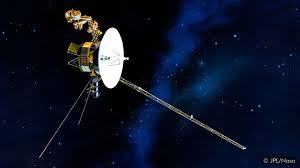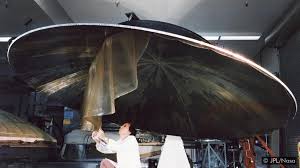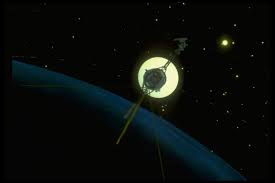Voyager: Inside the world’s greatest space mission

In 1977, two spacecraft started a mission that has redefined our knowledge of the Solar System – and will soon become our ambassadors on a journey into the unknown. lets look at their legacy, 40 years after launch.
You’ll find everything from the story about the world’s greatest space mission to the truth about whether our cats really love us, the epic hunt to bring illegal fishermen to justice and the small team which brings long-buried World War Two tanks back to life. What you won’t find is any reference to, well, you-know-what. Enjoy.
In a beige-coloured cubicle, on the ground floor of a nondescript suburban office block in Pasadena, California, history is being made. In fact, history is made here every day.
This is the Jet Propulsion Laboratory’s (JPL) mission control for Nasa’s Voyager spacecraft. You can tell that from the homemade cardboard sign beneath the computer monitors that reads: “Voyager Mission Critical Hardware PLEASE DO NOT TOUCH!” This is the unlikely control centre for one of the most ambitious and audacious missions in human history.
Over the past 40 years, the two Voyager spacecraft have explored Jupiter, Saturn, Uranus and Neptune. They have sent back detailed views of these strange worlds, revealing moons encased in ice, covered in volcanoes and bathed in gasoline smog. The missions have changed our perspective on the Earth and, with golden gramophone records attached to their sides, are now taking human culture to the stars.
Remarkably, both Voyager spacecraft are still working. Whenever Voyager 1 sends back a signal, it is from the furthest distance any human-made object has travelled from Earth.
Voyager 1 left the solar system in 2013 and is (at the time of writing) 20 billion kilometres (12 billion miles) away. Voyager 2, on a different trajectory, is 17 billion kilometres (10.5 billion miles) away. Maybe it’s easier to imagine it like this: it takes a radio signal, travelling at the speed of light, 38 hours to travel from the Earth to Voyager 1 and back. And it’s some 30 hours for Voyager 2. (For their latest position, visit the Voyager home page.)
The signals are received by Nasa’s deep space network – giant satellite dishes scattered around the world, designed to pick up data from distant spacecraft. As I watch, duty mission controller Enrique Medina calls-up a ground station near Canberra, Australia to establish contact with Voyager 2. The spacecraft is so far away, engineers need to line-up two receivers to capture the signal from the edge of the Solar System.
“The power of the transmitter on the spacecraft is around 12 watts,” says Medina. “When it’s on high power, it’s 20 watts – around the same as a lightbulb on a fridge.”
Think about that. I live in the countryside 40km (25 miles) from London and struggle to receive a mobile phone signal. Nasa can pick up messages from 20 billion kilometres away, sent using a 40-year-old, 12-watt transmitter.
“It never ceases to amaze me,” says Medina. “This is 1970s technology we’re talking about.” Voyager 1 is now touching the material that fills most of the Universe – Ed Stone, Voyager Project. As he talks, the screen fills with numbers – new data from our deep space avatars.

“Humans have been explorers forever,” says Voyager project scientist, Ed Stone. “This is just the newest human exploration by robotic means. Voyager 1 is now touching the material that fills most of the Universe.”
Stone is a legend among space scientists. Now in his 80s, he has been leading the Voyager mission at JPL since design and construction in 1972. “Voyager is the basis for almost everything I’ve done,” he says. “The mission has given us a much broader view of what’s out there – everywhere we look we find nature is much more diverse.”
The other legend behind the Voyager missions is the late Carl Sagan, who led the project to attach golden records to the side of each spacecraft. By the mid 1970s, the Cornell University astrophysicist and astronomer had become one of the world’s best-known scientists. As well as working on Nasa missions – including Viking 1, the first probe to land successfully on Mars – he wrote popular science books and was a regular contributor to TV and radio programmes.
With the golden records, Sagan was instrumental in transforming what was essentially a science mission, into an artistic and cultural mission. The copper disks, designed to last one billion years, resemble vinyl LPs and play in the same way with a needle, which is included in the engraved record casing. Intended as a message from planet Earth to alien civilisations, the records include speech, music, sounds and even pictures encoded in the grooves.
“We were trying to tell a little bit about what planet Earth was like, the beings that lived on it and, in particular, the species that made this record,” says artist Jon Lomberg, the design director for the golden record project. “The ground rules were that this wasn’t a message from Nasa or the United States but a message from planet Earth, reflecting the entire Earth and not the nation or agency that sent it.”
But Sagan and Lomberg had a problem: Nasa only gave them six weeks, from start to finish, to complete the project. “At the end of the six weeks, we had to have a physical record to give them,” says Lomberg. “That’s absurd.”
Around a third of the music on the golden disk is by western composers, including Bach, Beethoven and Mozart. However, there was also a genuine attempt to represent the music of the world. The selection features everything from Azerbaijani bagpipes to a girls’ initiation song from Zaire. It was possibly the first world music compilation album.
Voyager’s predecessors, Pioneer 10 and 11, famously had engraved plaques attached to their sides showing a naked man and woman. Although Duke Ellington, Chuck Berry and Native American music are represented, Elvis Presley – who died shortly before the Voyager 2 launch – is not on the disk.

“I think it’s amazing when you look at what they put on in terms of American music,” says Stephanie Nelson, a professor at California State University in Los Angeles and a world music specialist. “It’s [mostly] black American music, which is pretty interesting.”
But the music was the least controversial aspect of the whole project. Voyager’s predecessors, Pioneer 10 and 11, famously had engraved plaques attached to their sides showing a naked man and woman. The Voyager team hoped to include an image of a nude couple on the golden disk.
“I felt it was an essential part of the nature of humanity,” says Lomberg, who spent days searching for a suitable image that was neither pornographic or overly clinical. He came up with one of a pregnant woman. “It seemed to us to be just right,” he says. “But Nasa was having none of it, they said, ‘No way!’
“Whenever I speak about it to an audience, it draws a derisive laugh,” says Lomberg. “It just seems so petty, so revealing of something about ourselves that’s slightly ridiculous.”
Voyager 2 was launched from Cape Canaveral on 20 August 1977; Voyager 1 on 5 September. Although neither had any naked images on board, the timing of 1977 was no coincidence.
“That’s the year it could fly by all four giant planets,” says Stone. “We could launch the first spacecraft to Jupiter and Saturn and, if that succeeded, the second would go onto Uranus and Neptune.”
Some of the biggest scientific surprises came from the moons, which Voyager revealed to be much more than inert lumps of rock
As well as assisting the spacecraft, the position of the planets also affected the birth rate at JPL. “I tell my daughters their births are aligned with the planets,” says Linda Spilker, who began her career on Voyager and now heads the Cassini mission to Saturn. “This was very calculated – you’ll find a lot of Voyager babies born in the five years between Saturn and Uranus.”
In 1979, 18 months after launch, Voyager 1 and 2 began their exploration of Jupiter, revealing its churning clouds in unprecedented detail. The quality of the images from the on-board television camera was remarkable.
“Every time an observation came through, it was always new,” says the head of the imaging team, Garry Hunt. Based at Imperial College London, Hunt was the only senior British scientist on the mission. “History was changed.”
Some of the biggest scientific surprises came from the moons, which Voyager revealed to be much more than inert lumps of rock. “Before Voyager the only known active volcanoes were on Earth,” says Stone. “Then we flew past Io, a moon of Jupiter around the size of our Moon, and it had 10 times the amount of volcanic activity of Earth.”
Voyager turned our Earth-centric view of the Solar System on its head. “Before Voyager, the only known liquid ocean was here on Earth,” says Stone. “Then we saw [Jupiter’s moon] Europa with its cracked surface and it subsequently turned out that there was a liquid water ocean beneath the surface.”
The original image archive for the mission is now confined to a dusty filing cabinet in a side room at Queen Mary College in east London. With all the images digitised, the cardboard photos inside are rarely looked at. But when the BBC reunites Hunt with the original pictures, he is taken aback by their quality. Particularly an image captured in 1980, as Voyager 1 reached Saturn.
“That was such a shock to us,” Hunt says, as he flicks through images of Saturn’s rocky moon Mimas. “We called it ‘Death Star’.”
Taken in the same year as the release of the second Star Wars movie, The Empire Strikes Back, it is astonishing how much like a fully-operational battle station the moon appeared to be. A substantial conical chunk was knocked out of it by a massive collision. “It’s an enormous impact,” says Hunt. “It was almost the absolute limit before it would fragment, [and] with Star Wars in the cinemas it [Mimas] became Death Star.”
The very last object Voyager 2 would see was among the highlights of the entire mission But that wasn’t the only surprise at Saturn. As well as finding new rings and identifying an additional moon, the Voyager spacecraft investigated the moon of Titan with its thick petrochemical atmosphere and methane rain. It also sent back close-up images of the moon Enceladus. This tiny, ice-encased world, around the size of the UK, is the most reflective body in the Solar System. Both moons have subsequently been investigated by the Cassini-Huygens mission, with Enceladus now ranked as a prime candidate for life.
“Every single one of the moons is unique,” says Emily Luckdawalla, senior editor for the Planetary Society. “Voyager taught us what we needed to send to Saturn to understand the nature of its moons.”
In November 1980, Voyager 1 left Saturn behind to begin its long journey out of the Solar System. Nine months later, Voyager 2 set course for the outermost planets. It reached Uranus in 1986, snapping the first pictures of the gas giant, its rings and also discovered 10 new moons.
When the spacecraft reached its final planetary destination, Neptune, in 1989, it was the moons which again caught the scientists’ attention. The very last object Voyager 2 would see was among the highlights of the entire mission.
“When we flew by Neptune’s moon Triton, we saw geysers of nitrogen erupting,” says Stone. “Time after time we found things on Earth happening all over the Solar System.”
Several missions have built on the legacy of Voyager – as well as the Cassini-Huygens mission to Saturn, the Galileo and Juno probes have visited Jupiter and more missions are in the pipeline. No new missions are planned to Uranus or Neptune – the Voyager 2 images remain the state of the art.
Few expeditions in the entire history of mankind have notched up so many scientific achievements as the twin Voyager probes. But we also owe a great deal to its technological legacy.
“This was the first computer-controlled spacecraft ever launched,” says Stone. “It still flies itself, it runs itself, it checks itself and it can switch to backup systems by itself.”
We use spin-off technologies from Voyager every day. “Because the signals coming from deep space are so weak, we had to develop coding systems,” explains Stone. “Cell phones and CD players rely on the same technology – but the coding was developed for sending things into space.” Similarly, the image processing capabilities built into smart phones have evolved from technology originally developed by Voyager engineers.
It’s such a tiny thing floating in space and Earth is where all life we know of exists – Emily Luckdawalla, Planetary Society But perhaps the greatest moment for Voyager came on 14 February 1990. This was the day Voyager 2 turned its cameras back towards the Earth to capture a view of the entire Solar System. A view in which the Earth is merely a single-pixel pale blue dot, giving us a sense of our place in the cosmos.
“It’s such a tiny thing floating in space and Earth is where all life we know of exists,” says Luckdalwalla. “It’s almost frightening when you perceive it in that Voyager image, in that sunbeam. Sometimes it looks like a laser beam with Earth fixed in it.”
“One event could wipe out all the life we know of in the Universe,” she adds. “It’s a precious image that helps us understand how fragile and small our place is in the Universe.”
In 2013, Voyager 1 crossed the boundary between the space dominated by the Sun’s magnetic field and the space between the stars. “The Sun creates this huge bubble around the planets,” says Stone. “This is a partial shield from the cosmic rays outside – we’re now learning how our bubble interacts with the material from other stars.”
Voyager 1 continues to collect information about the void and, in the coming years, Voyager 2 will also pass beyond the Solar System. Because it’s leaving at a different angle to its twin, the data Voyager 2 gathers will give scientists an insight into the shape of the solar bubble.
But time is running out. The spacecraft are powered by nuclear batteries with electricity generated from heat produced by the decay of plutonium. Every year, four watts less heat is produced.
“The objective is to keep them flying as long as possible,” says Voyager programme manager, Suzy Dodd. “You can imagine them being twins and over the course of nearly 40 years, one has lost hearing, the other doesn’t see so well, so we have to be very careful.”
“We’ve been turning off redundant systems,” she says. “We only operate the instruments that can take data where the spacecraft are – we don’t operate the cameras anymore because there’s nothing to see – it’s just very, very dark space.”
Some of the power is used to keep heaters operating, to ensure the spacecraft instruments don’t freeze.
One day – probably in the next 10 years – Dodd knows that Voyager 1 and 2 will have to be shut down. “I think it’s going to be a very sad day for Nasa and for humanity – it’ll be like losing a grandparent or close relative who’s lived a full and very rewarding life,” she says. “One day we’ll be looking for a signal from Voyager and we won’t get it.”
The Voyager spacecraft will become our silent ambassadors to the Milky Way – Ed Stone
In a way, however, the Voyager mission will last forever. Probably longer than human civilisation.
“I would like to think that sometime in the future, something or somebody will find them, play the golden record and look at what, by that time, will be an ancient civilisation,” says Dodd. “Our Earth may be long gone by the time that golden record is found.”
“The Voyager spacecraft will become our silent ambassadors to the Milky Way,” adds Stone. “They will be in orbit around the centre of the galaxy for billions of years.” But he’s not as optimistic as Dodd that the Voyagers will ever be discovered. “It’d be remarkable – space is really empty.”
But maybe that’s not the point. With their time capsules from Earth, the Voyager missions are carrying the world of 1977 into the distant future. Voyager has made humanity immortal.





